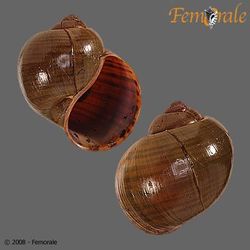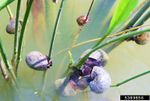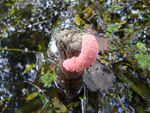Amazonian apple snail
| Amazonian apple snail |
|---|

|
| Scientific Classification |
|
| Scientific Name |
|
Pomacea maculata |
| Shell of the Amazonian Apple Snail |
The Amazonian Apple Snail is a species of snail known by the scientific name Pomacea maculata. This snail is known for being the size of an apple (as included in the name) and is an invasive species. This snail causes major problems and is really hard to get rid of. Along with great camouflage skills, burying, huge size and insane reproductive rate this snail is just about the grossest invasive species. Coupled with its easy living in the lake it is really good at being invasive. If you want to find out more about how this snail works read below.
Body Design
This snail is great at being an invasive specie in just about every way possible. First the Amazonian Apple snail grows to the size of a mans fist, which isn't all that bad because you would think they would be easy to spot. Well, it turns out that they blend in with the bottom of a muddy bank and go all the way to the bottom making it very hard to spot them. Not only that they can manage to trap enough air in their shell to float. That also may seem like a good thing until you considered how they supposedly go their in the first place. In that case whenever their is a flood in that area the snails will float every where and continue spreading. These snails also contain many parasites' which include rat lungworm and many others that infect humans if they eat the snail. So their is no way to get rid of them by eating. They also have little Siphon's that allow them to breath just under the surface of the water which comes in handy when the floating around. One of the worst parts of the Amazonian Apple Snail is its eggs which it lays by the thousands in pink sticky egg cases.[2]
Given their size the Apple snail is said to be the biggest living fresh water snail on earth. The Apple will eat just about anything causing some problems which will be mentioned later. The Apple Snail has gills but is used to a less oxygenated water so they usually wait till they think its safe and breath up for water from their siphon. their siphon can reach up to 4in (10cm) long.[3]
When the snail dies it just sits still. Which can get really surprising especially if it just hangs on the wall of an aquarium. The Apple Snail has to eyes and sense bristles which give it a very strong olfaction (sense of smell) because of this they can find food surprisingly fast. Although a bit shocking a lot of fish especially spineless ones will suck the snail out of its shell and even if it cant eat the snail the fish will completely destroy the snail. Which leads to the question of where are the fish in the place where its invading? most fish where its invading either haven't discovered it or stop eating it because of a foul taste. Not only that once again they can float which can get them moving quickly if they need to. [4]
Life Cycle
The Life Cycle of an Amazonian Apple Snail differentiates throughout their life. Amazonian Apple Snails reproduce at their highest rate during the spring and summer time because of the availability of food and the temperature. The higher amount of those there are, the shorter life cycle and remain reproductive for a longer period of time. The lower the temperature and the availability of food there is, the longer the life cycle is and the more the reproduction rate lessens.[5]
The apple snails have hundreds of red eggs, ranging from 200 to 600. They are all located above a waterline before the snails are reproduced. The amount of light an apple snail receives has little or no impact to its growth. [6]
Ecology
The Apple snail is native to South America. Apple snails live in swamps, ditches, ponds, rivers, and lakes. Most snails apple snails prefer calm waters, to choppy waters like rivers. The Apple Snail can fill its lungs to float on the surface. Some times when the water gets down to 10 degrees Celsius, the Apple snail can't survive. Apple Snails can eat everything in their environment, but they prefer soft and easier to digest foods. They eat plants, and algae and are mostly vegetarian. The Apple snails crawls to the surface, and lets out foot-funnel to trap all the particles floating on the surface. Some Apple snails are known to predate on each others eggs. They do this for high value nutrition.[7] [8]
Invasive Species
Location and Method of Introduction
The Amazonian Apple Snail is native to South America. They were first found in the US in 2002, when they were seen in Florida. They are now also located in areas such as Alabama, Arizona, Georgia, Texas, Louisiana, Mississippi, South Carolina, Puerto Rico, throughout the Southern Atlantic, and Asia. Although they spread rapidly, they can not survive in areas any less than 50 degrees Fahrenheit.[9] It is not known where the first Amazonian apple snail was found, but they were originally assumed as a food source. They spread rapidly, destroying parts of wetlands and crops, especially in Asia. [10]
Environmental Impact
The Island Apple Snail is an invasive fresh water species. The Apple Snail population increases at very high rate. The Snails lay their eggs ranging up to or more then 2,000 eggs, and they lay them above the waterline. The Amazonian apple snail was introduced to the US, Asia, Australia, and other locations, around 1980. The population spreads quickly during floods, canals, and rivers. They feed on plants that other fish, and creatures depend on, and they also eat rice. For the farmers in total it costs hundreds of thousands of dollars, to control the population. Once the Invasive Apple Snail starts eating the rice or leaves it is hard to control them. This could lead to the destruction to the plant, which leads to unstable sediments, and that leads to poor water quality. When the wetlands become weak it reduces the ability for the plants to withstand storms, or hurricanes. The also carry parasites that are harmful to humans, such as the rat lungworm, trematodes and nematodes. They cause headaches, neck pain, and a lot of other side effects. Once people started noticing the heavy impact the snail was, America restricted of transporting the Apple Snail. [11]
Control Methods
Their are two methods of controlling the snail. The first but unsuggested one is eating them. The reason this goes on suggested is because first they have to be cooked perfectly or else they will infect you with parasites(as seen above). Second they might spread if people like them. The next control method is just getting a group and pick up the eggs and snails. After your get done rounding up you have to freeze them then bury them so the predators don't get the snail bodies. [4]
References
- ↑ Pomacea maculata . Web. last updated September 12, 2017 unknown author
- ↑ Pillion, Denis. The Amazonian Apple Snail may be our grossest invasive species yet Al.com. Web. .
- ↑ Ampullariidae Wikipedia. Web. July 4, 2017. Author Unknown.
- ↑ Ecology of apple snails The apple snail website. web. 11/6/17 (date accessed).
- ↑ Channeled Apple Snail Aquatic Invasive Species. web. updated 6/05.
- ↑ The identity, distribution, and impacts of non-native apple snails in the continental United States web. US National Library of Medicine - National Institutes of Health. Last accessed November 12, 2017. Author unknown.
- ↑ . Ecology of apple snails The Apple Snail website. Web. November 10, 2017. last accessed November 10, 2017.
- ↑ Swearingen, J., C. Bargeron.island applesnail Pomacea maculata Perry, 1810Invasive Plant Atlas of the United State.web. 22 October, 2015 (last updated).
- ↑ The apple snail: a creeping threat to the environment?European Food Safety Authority.web. 18 February, 2014 (published).
- ↑ . Amazonian Apple Snail "Alabama Cooperative Extension System". last accessed November 12, 2017. last update June 2013.




